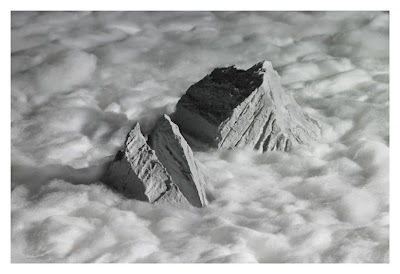



Work from Standing Waves and Postcards.
Spend time on his website, the vast majority of his works are excellent.
"Notions of authenticity and artificial images are at the heart of Missikaʼs work. He subtly explores the relationship between the viewer and the world and depictions thereof. While his works reflect the visual symbolism of the media and popular culture, he is also clearly influenced by art history and the history of photography and by their manifestations in contemporary photography. This is hardly surprising, given that Missika finds inspiration for his landscape images from sources as diverse as comics and fantasy films, postcards and magazines, art history and natural sciences like geology and archaeology. As a result, his art oscillates between fiction and reality. Missika repeatedly mixes photographs taken on his many travels with the staged photographs that he takes in his studio and with material he finds in magazines or on the internet. Although he trained as a photographer and is a true master of his art, he is primarily interested in pictures as the formal outcomes of ideas that lead him through a wide variety of media. Missika believes that every picture on display is a constructed internal landscape, an espace mentale. Missikaʼs postcard motifs depict “archetypal” subjects: a sunset, a mysterious cave, a craggy peak emerging from a sea of clouds, a mountain range. They awaken memories of things we have seen or experienced before – we are all familiar with the beguiling images from postcards that we have sent or received from all over the world. Missikaʼs work explores imagination and reality: Is paradise a perfect thing in our imagination, something that reality fails to live up to? Or is it precisely the opposite – is any attempt to capture the beauty of a breathtaking landscape doomed to failure? Some of Missikaʼs pictures reveal similarities to historical paintings such as Chalk Cliffs on Rügen by Caspar David Friedrich, which is on display at the nearby Museum Oskar Reinhart am Stadtgarten.
Yet Missika builds up this sense of romanticism only to destroy it immediately, revealing it as nothing but a sham. The postcards may play with our perceptions, but somehow they prevent the illusion from evaporating entirely – even once the viewer realises that the sea of clouds is actually made of cotton wool, a remnant of the romance of a mountain peak lingers. The way these “images of nature” work is so simple it is almost funny: Viewers recognise their own desire to surrender to the illusion yet see through this desire just moments later. Missika presents us with mirages. His craggy peaks tower over cotton-wool clouds and his mountain ranges are made of folded plastic film. The illusion is short-lived – it lasts only as long as it takes us to work out what exactly we are seeing. Missika uses this technique to reflect on the superficial treatment of visual material in this day and age and on the flood of images we are confronted with in our daily lives." - Alexandra Blättler
No comments:
Post a Comment